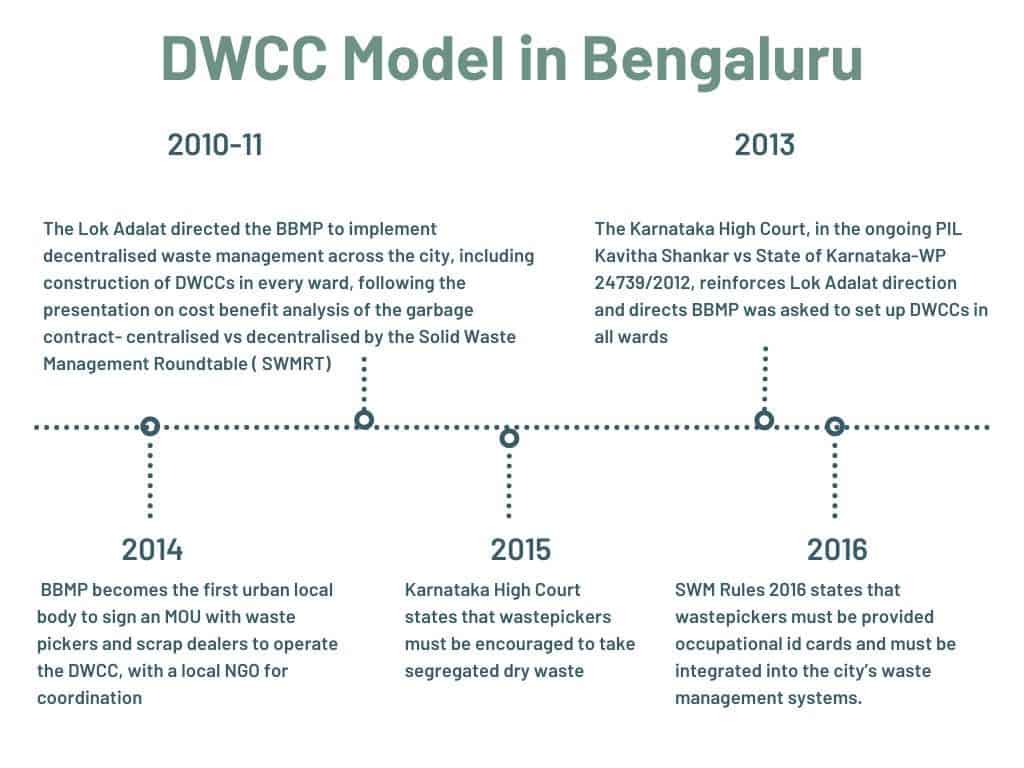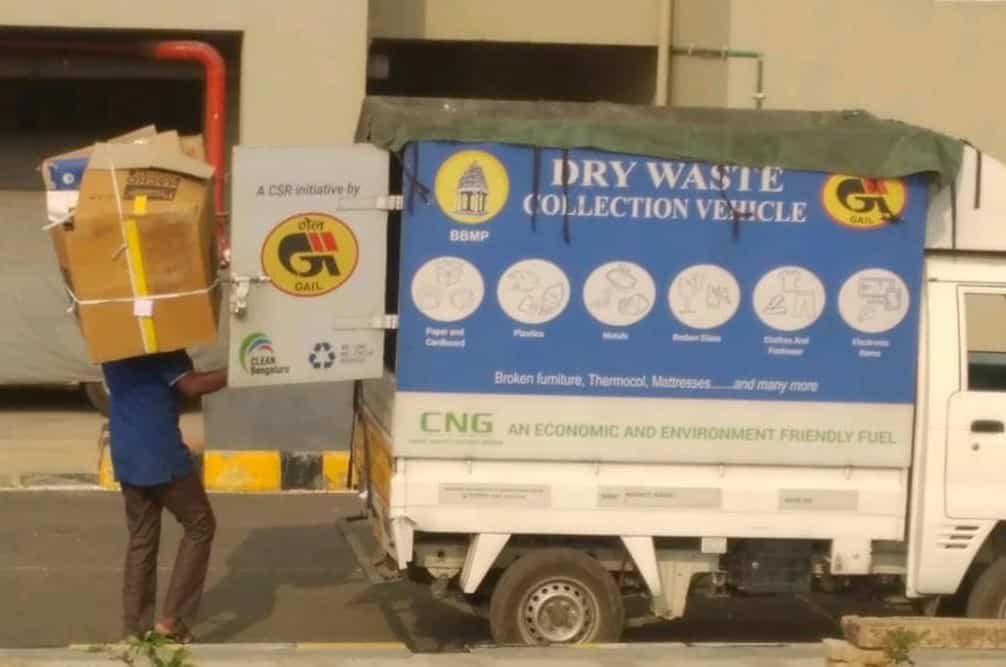A lone tempo with jumbo bags hanging from the edges and plastic bags of mixed waste piled high in the van are a familiar sight in Bengaluru. Despite the fact that in the last few years, wards that started to use separate vehicles to collect different streams of waste saw much better quality of waste collection. It ensured waste that was easy to recycle did not get sent to landfills or burnt on the wayside.
Recently, BBMP said they plan to discontinue sending separate vehicles to collect dry waste and will look at a single vehicle having compartmentalised spaces collecting all waste streams. Sustainable waste management experts and citizen groups question the rationality and economic viability of this plan.
Waste may end up getting mixed in a single truck worry activists. “This will slowly impact the quality of segregation because people will feel what’s the point if it’s going to be mixed again”, says Odette Katrak, Co-founder, Beautiful Bharat.
The Swachh Bharat Mission Urban Guidance on Efficient Collection and Transportation of Municipal Solid Waste issued in July 2020 clearly states it is important to collect and transport segregated waste scientifically.
Read more: Solid waste management: BBMP budget prioritises the worst solution of them all, more landfills
Is this BBMP plan geared towards more landfill-based management, as opposed to decentralised waste management? The recent budgetary allocations point to exactly that – a whopping Rs 300+ crores or 22% of the total SWM budget has been allocated for managing landfills.
Other questions that remain unanswered:
- How will the BBMP ensure integrity of the segregated waste?
- What happens when households continue to deposit mixed waste to the vehicle?
- Will one vehicle solve the problem of black spots?
- How can the ULB step up implementation?
- Going by the ward microplan model, what will be the time interval between pick up and delivery at designated point.

How the waste collection process improved after 2017
In 2017, BBMP, seeking to improve segregation levels passed an order stating dry waste will only be collected twice a week. The BBMP also stated their intention of decentralising collection and transportation of waste. As part of this move, DWCCs were asked to pick up dry waste.
The first DWCC to start door to door collection of dry waste was in Ward 163 – Katriguppe. This was followed by Wards 194 – Gottigere, 195 – Konanakunte, 150 – Bellandur and others. DWCC operators were provided basic infrastructure and had to do secondary sorting and aggregation. They sustained themselves from the money they earned from selling the dry waste. BBMP’s data portal was useful in capturing and tracking the quantity of dry waste collected and sent up the value chain.
In 2018, BBMP appointed Resource Organisations (RO) – non profits that facilitated decentralised dry waste management systems with operation support, training, awareness and communication. ROs empowered waste pickers to manage the centres independently and become social entrepreneurs.
“This helps fulfil an important clause that is waste picker inclusion, as outlined in the Solid Waste Management rules 2016”, says Rajesh Babu, Cofounder Swachha Eco Solutions. Swachha is one such Resource Organisation that supports and oversees door-to-door collection and transportation of dry waste from four divisions of Bengaluru covering 28 Wards having around 3.92 lakh households and a population of 15.7 lakhs.
When BBMP announced their decision in January 2020 to penalise residents for non segregation, volunteers were miffed with the lack of implementation and enforcement and demanded separate vehicles.
In September 2020, the BBMP decided to implement a new garbage disposal system in 38 wards, with separate vehicles collecting wet, sanitary and dry waste , as per the ward micro plan. This was implemented after a pilot was conducted at Govindrajnagar ward (104). However, the old practice continued in areas where DWCC operators were picking up waste separately.
Separate vehicles collecting dry waste saw more segregation
In December 2020, BBMP found segregation levels had improved by up to 39% in these wards. The top performing wards were Singansandra, Rayapuram, Nayandahalli, Mangamanpalya and Uttarahalli.
Prior to door-to-door collection by DWCCs, the average waste received at the centres was around 600-800kgs per day. Much of the high value waste was sold by BBMP pourakarmikas/auto tipper drivers. Much of the waste reaching the DWCCs was of low value. Some of this was also dumped by the wayside or burnt. “Post the introduction of separate vehicle for dry waste, the average received has increased to 2.5 tons”, says Rajesh of Eco Solutions. This was because segregation and collection improved and better quality of waste reaching DWCCs making their operations it more economically viable.
“Dry waste vehicles (and DWCCs) have worked more closely with citizen groups as their income is dependent on better pick up and segregation”, says Anjali Saini, Member, Whitefield Rising.
Read more: Brand Audit 2021: Here are Karnataka’s top producers of plastic waste
Segregation levels have definitely gone up in the wards that have had separate collections for over three years. “From our experience, segregated vehicle collection of dry waste is yielding positive results in segregation at source,” says Vishwanath C, Manager, Livelihoods Hasiru Dala. “While average is about 46% where collection started a year back, In Konanakunte and (Bangalore south division) which started segregated collection three years ago, the collection rate is 100%. People are getting used to the twice a week collection.” (Collection Rate is based on actuals vs estimated waste based on ward microplans calculations).
| Sl. no | Period | Total Incoming Waste DTDC & PK’s Drop Off (in MTs) | Total Recyclables (in MTs) | MLP’s/ non recyclables sent for co-processing (in MTs) | Total Wards Engaged in DTDC |
|---|---|---|---|---|---|
| 1 | 2017-18 | 9,171.25 | 2,751.38 | 6419.88 | 27 |
| 2 | 2018-19 | 9,908.19 | 2972.46 | 6,935.73 | 19 |
| 3 | 2019-2020 | 8,713.58 | 2,614.07 | 6,099.51 | 21 |
| 4 | 2020-2021 | 11,091.69 | 3,327.51 | 7,764.18 | 44 |
| 5 | Jan 2021- Dec 2021 | 15,581.67 | 4,674.50 | 10,907.17 | 40 |
| Total | 54,466.38 | 16,339.91 | 38,126.47 |

“We were delighted when BBMP shifted to different vendors for collection of dry waste and wet waste in 2017,” says Odette Katrak. “It made the job easier for all ground volunteers, working hard to push for proper segregation and no mixing of waste, either at the household collection level or the vendor stage. Why change something that is working well?”
Evaluating what is happening on the ground
“Policies cannot be made in the conference room”, says Aparna Kumar, waste management volunteer, Ward 177 – JP Nagar. “In Bengaluru, citizens’ movement has expanded and most of the work has happened after trial and errors and the systems were refined. Without basic evaluation and consultation, there is no point in changing policies”.
“It’s a pity that there has been no consultation, no data analysis, no discussions,” adds Rajesh. “Any new process needs to have a justification process and if accountability is the issue, BBMP needs to go back and check the records. The BBMP had made it mandatory to install GPS in all dry waste vehicles, and RFID was placed. There were signature books and all data had to be entered on the BBMP portal. In addition, photos were also to be sent to the BBMP”.

Need to support dry waste collection system
“BBMP needs to fix destinations,” says Aparna Kumar. “If destinations are weak, there is no point in segregation. DWCCs, for example, are essential infrastructure facilities, yet they continue to be neglected, despite the excellent contribution they make in retrieving materials, especially low value waste, and we have statistics to prove that.
“We need to enhance capacities of (models) with (high) potential like the separate dry waste collection system.”